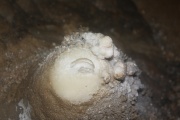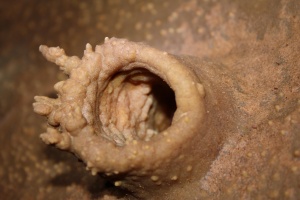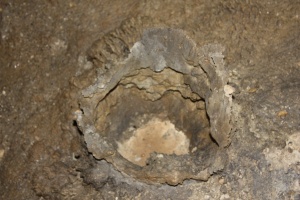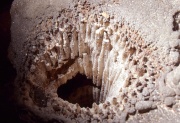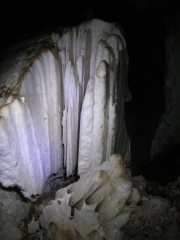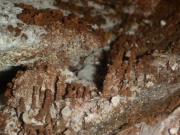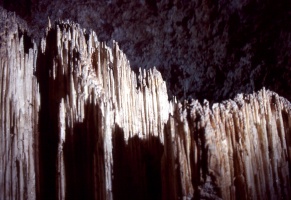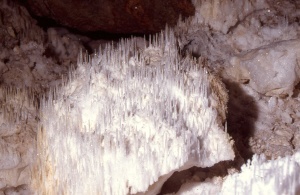Karren (Inventory)
From LagWiki
Contents |
Drip pit, carbonate
The Drip pit, carbonate field should be used to record any observation of a drip pit except for those in gypsum which has its own field.
A drip pit is a depression or hollow which is formed from dripping water. It can appear as a shallow depression in almost any floor material especially soft materials like guano, sediments like mud or gravel and moonmilk; but they can also form in harder carbonate materials like flowstone or stalagmites or directly in the bedrock.
Drip pits can vary in size from small depressions to deep, hollow, drill holes. Drip pits can be lined with calcite (see drip pit lining) which is one of the stages in forming a conulite. They may or may not be filled with water and can possess a cave pearl at the bottom.
Examine the floor and any shelves which may exhibit drip pits.
See also
Drip pit, carbonate, Karren
Drip pit, gypsum
The Drip pit, gypsum field should be used to record any observation of a drip pit in gypsum. Drip pits in other material have their own field.
A drip pit is a depression or hollow which is formed from dripping water. It can appear as a shallow depression in almost any floor material. This field should be used only to record drip pits in gypsum.
Drip pits can vary in size from small depressions to deep, hollow, drill holes.
Examine the floor and any shelves made of gypsum which may exhibit drip pits.
See also
Pothole karren
Karren (Inventory)/Pothole karren
Rillenkarren
The Rillenkarren field is used to record stations that exhibit rillenkarren.
Rillenkarren are etched flutes or channels which are dissolved or eroded by dripping or flowing water. They usually exhibit as parallel channels or flutes. The hollows or "rills" may narrow and disappear with distance or, when dissolved by acid rich water like in the Guadalupes, may become deeper with distance. This latter type should probably be called "rinnenkarren" because of this characteristic but for purposes of the Carlsbad Cavern National Park Cave Inventory Form, they are inventoried in this field.
Rillenkarren may form on soft materials like guano or sediments. They can also form in harder materials like bedrock or massive gypsum. The defining characteristic is multiple channels separated by ribs of undissolved or uneroded material. The grooves are rounded troughs with sharp ridges.
See also
References
- Klimchouk, Alexander B.; Ford, Derek C.; Palmer, Arthur N.; Dreybrodt, Wolfgang (2000) Speleogensis; Evolution of Karst Aquifers National Speleological Society, Huntsville, AL p 423 ISBN: 1-879961-09-1
- unknown (1997) Geology of Carlsbad Caverns Class - 1997 Memorial Day Expedition p 2
Spitzkarren
The Spitzkarren field of the Karren section should be used to list stations which exhibit spitzkarren.
Spitzkarren are tower-like formations left by water dripping on dissolvable or erodable substrate like bedrock, breakdown, gypsum, sediment, guano, or even corrosion residue (speleosol). It could be considered the opposite of rillenkarren which form as rills or hollows. Spitzkarren exhibits as sharply spiked, angular and pointed.
See also
References
- Klimchouk, Alexander B.; Ford, Derek C.; Palmer, Arthur N.; Dreybrodt, Wolfgang (2000) Speleogensis; Evolution of Karst Aquifers National Speleological Society, Huntsville, AL p 423 ISBN: 1-879961-09-1
- unknown (1997) Geology of Carlsbad Caverns Class - 1997 Memorial Day Expedition pp 2-3
Spitzkarren, Karren
